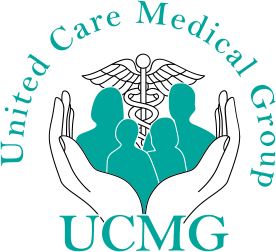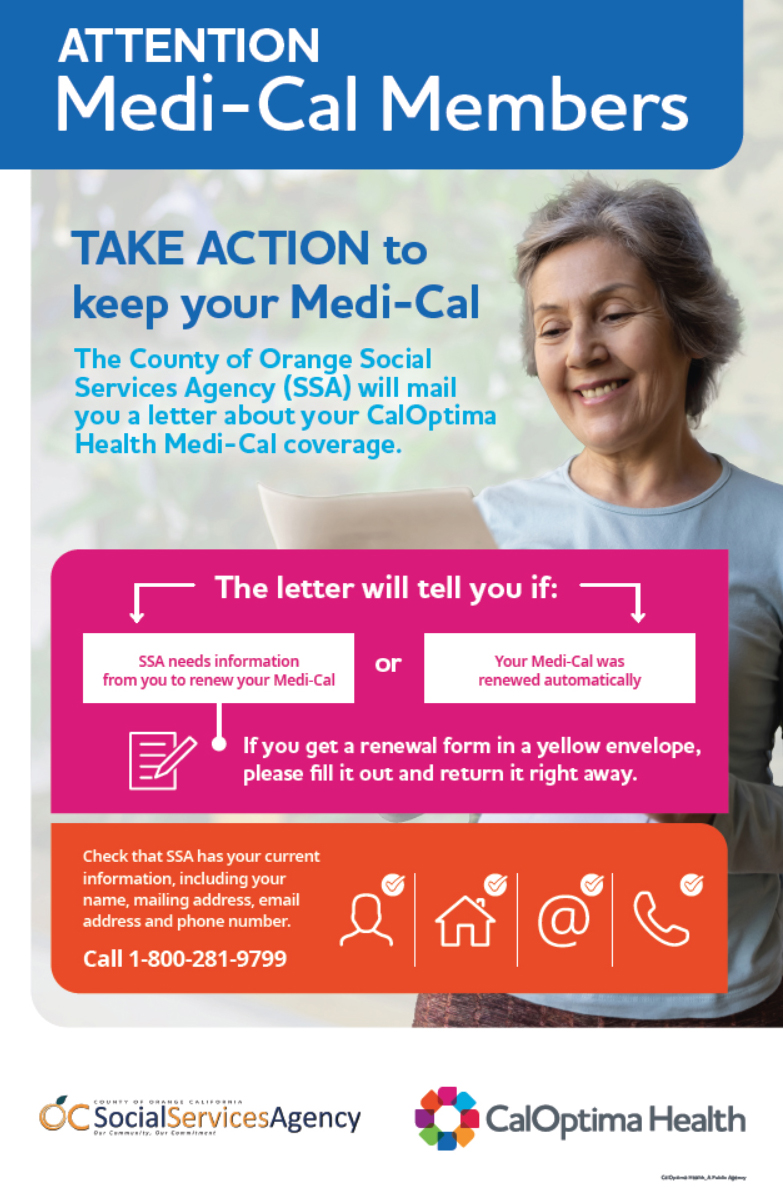
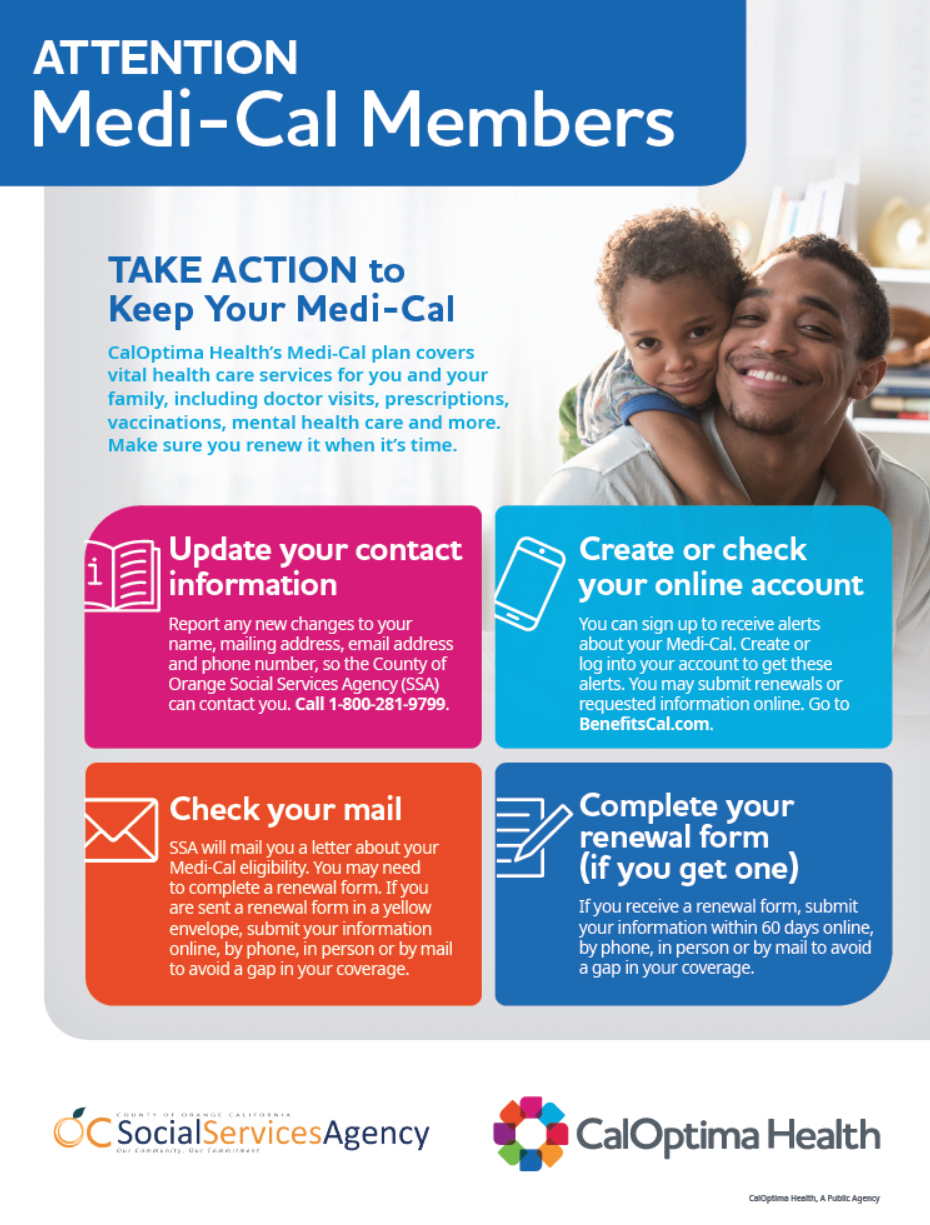
Important Notice: Keep your Medi-Cal coverage
Take steps to keep your Medi-Cal coverage! It’s time to update your contact info and report any changes to the County of Orange Social Services Agency (SSA). Visit BenefitsCal.com or call SSA at 1-800-281-9799 today.
Look out for a yellow envelope in the mail. It’s your Medi-Cal renewal form, and you have 60 days to return it online, by phone, in person or by mail to avoid a gap in coverage. Contact the County of Orange Social Services Agency with questions at 1-800-281-9799 or visit BenefitsCal.com today.
For more detailed information, please visit the website: KeepYourMedicalCoverage.org
Need help with your annual renewal? Contact the Health Consumer Alliance for a free, confidential consultation at 888-804-3536 (TTY 877-735-2929).
County of Orange Social Services Agency:
Facebook: https://www.facebook.com/OCSSA1
Twitter: https://www.twitter.com/OrangeCountySSA
CalOptima Health:
Facebook: https://www.facebook.com/CalOptima
Twitter: https://www.twitter.com/CalOptima
Instagram: https://www.instagram.com/CalOptima
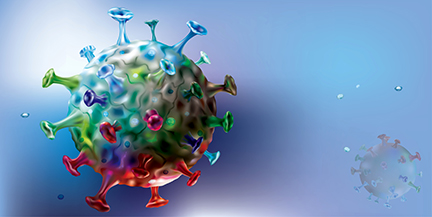
Updated News of Covid 19
According to CDC data as of August 14, 2021, in the USA there are 836,664 new cases: +804 new deaths. In Orange County, California, between August 3 and August 10, the seven-day average case rate jumped from 14.8 to 19.4 per 100,000 people, with the average number of daily COVID-19 cases rising from 477 to 627. The positivity rate also increased from 7.2 to 8.3 percent, hospitalizations from 375 to 495 per day, and ICU admissions from 68 to 91 per day.
“As with many viruses, COVID-19 is frequently changing,” says Dr. Regina Chinsio-Kwong, Deputy County Health Officer. “These changes result in new versions of the virus called ‘variants.’ We're particularly worried about the Delta variant because this version is spreading easily between people and causing more severe illness. That’s why it’s so important for residents who are not yet fully vaccinated to get the vaccine and to complete both doses. By doing so, you would be protecting not only yourself, but also those who are most at risk of getting COVID-19 including our elderly and those with underlying health conditions, as well as children under age 12 who have no option of getting vaccinated.”
Source https://occovid19.ochealthinfo.com/coronavirus-in-oc
Millions of People Have Safely Received a COVID-19 Vaccine
Over 351 million doses of COVID-19 vaccine have been given in the United States from December 14, 2020, through August 9, 2021.
COVID-19 vaccines are safe and effective. COVID-19 vaccines were evaluated in tens of thousands of participants in clinical trials. The vaccines met the Food and Drug Administration’s (FDA) rigorous scientific standards for safety, effectiveness, and manufacturing quality needed to support emergency use authorization (EUA).
Millions of people in the United States have received COVID-19 vaccines since they were authorized for emergency use by FDA. These vaccines have undergone and will continue to undergo the most intensive safety monitoring in U.S. history to make sure that COVID-19 vaccines are safe.
Results Are Reassuring
Results from vaccine safety monitoring efforts are reassuring. Some people have no side effects. Others have reported common side effects after COVID-19 vaccination, like swelling, redness; pain at injection site; fever; headache; tiredness; muscle pain; chills; nausea...
Serious Safety Problems Are Rare
To date, the systems in place to monitor the safety of these vaccines have found only two serious types of health problems after vaccination, both of which are rare. These are anaphylaxis and thrombosis with thrombocytopenia syndrome (TTS) after vaccination with J&J/Janssen COVID-19 Vaccine.
Anaphylaxis
A small number of people have had a severe allergic reaction (called “anaphylaxis”) after vaccination, but this is rare. Anaphylaxis can occur after any vaccination. If this occurs, vaccination providers have medicines available to effectively and immediately treat the reaction.
After you get a COVID-19 vaccine, you will be asked to stay for 15–30 minutes so you can be observed in case you have a severe allergic reaction and need immediate treatment.
Thrombosis with Thrombocytopenia Syndrome (TTS) after Vaccination with J&J/Janssen COVID-19 Vaccination
After receiving the J&J/Janssen COVID-19 Vaccine, there is risk for a rare but serious adverse event—blood clots with low platelets (thrombosis with thrombocytopenia syndrome, or TTS). Women younger than 50 years old should especially be aware of their increased risk for this rare adverse event. There are other COVID-19 vaccines available for which this risk has not been seen.
This adverse event is rare, occurring at a rate of about 7 per 1 million vaccinated women between 18 and 49 years old. For women 50 years and older and men of all ages, this adverse event is even more rare.
Cases of myocarditis and pericarditis in adolescents and young adults have been reported more often after getting the second dose than after the first dose of one of these two mRNA COVID-19 vaccines. These reports are rare and the known and potential benefits of COVID-19 vaccination outweigh the known and potential risks, including the possible risk of myocarditis or pericarditis.
Long-Term Side Effects Are Unlikely
Serious side effects that could cause a long-term health problem are extremely unlikely following any vaccination, including COVID-19 vaccination. Vaccine monitoring has historically shown that side effects generally happen within six weeks of receiving a vaccine dose. For this reason, the FDA required each of the authorized COVID-19 vaccines to be studied for at least two months (eight weeks) after the final dose. Millions of people have received COVID-19 vaccines.
(Source CDC)
HOSPITALS / MEDICAL PROVIDERS IN ORANGE COUNTY
| COVID-19 Vaccine Providers |
Link for Information |
|---|---|
| Hoag Memorial Hospital |
|
Kaiser Permanente |
|
MemorialCare Health Systems |
|
Providence |
|
UCI Health |
PEDIATRIC (PFIZER) PROVIDERS FOR ELIGIBLE CHILDREN (12+) (AS OF 5/12/21)
| Orange County Region |
COVID-19 Vaccine Providers |
Location/Contact Information |
|---|---|---|
Northern OC |
California Pediatric & Adolescent Care |
Call to schedule (714) 723-0094, located at 3340 W. Ball Road, Suite A, Anaheim, CA 92804 |
New Light Medical Group |
Call to register (714) 635-0600. Address:1716 W Medical Center Dr, Anaheim, CA 92801 |
|
Planned Parenthood - Anaheim Katella |
Call (833) 422-4255 for MyTurn scheduling or visit https://myturn.ca.gov/. Address: 801 E. Katella Ave., Anaheim, CA 92805 |
|
Korean Community Services |
7212 Orangethorpe Ave., Suite 9A, Buena Park, CA 90621 - (714) 503-6550 |
|
Central OC |
Children's Hospital of Orange County |
1201 W. LaVeta Ave., Orange, CA - (714) 509-4668 |
Families Together of Orange County |
9918 W Katella Ave., Suite A, Garden Grove, CA 92804 - (714) 644-9494 |
|
Memorial Care Group - Brookhurst |
18035 Brookhurst St., Suite 2100, Fountain Valley, CA 92708 - (657) 241-9090 |
|
Miyoco Medical Center |
15975 Harbor Blvd., Fountain Valley, CA 92708 - (714) 546-6575 |
|
NhanHoa Comprehensive Health Care |
7761 Garden Grove Blvd., Garden Grove, CA 92841 – (714) 898-8888 |
|
SOS Children Family Health Center |
307 Placentia Ave., Suite 107, Newport Beach, CA 92663 - (949) 270-2153 |
|
South Coast Pediatrics |
Register at www.southcoastpediatrics.com or call at (714) 754-1444. Address: 2650 S. Bristol St, Suites 101- 103, Santa Ana, CA 92704 |
|
Southland Integrated Services, Inc |
9862 Chapman Ave., Garden Grove, CA 92841 - (714) 620-7001 |
|
Southern OC |
Marque Urgent Care - Aliso Viejo |
Register through https://myturn.ca.gov |
MemorialCare Medical Group - Aliso Viejo |
26538 Moulton Pkwy., Suite 38E, Laguna Hills, CA 92653 - (949) 448-0656 |
|
MemorialCare Medical Group- SJC |
31001 Rancho Viejo Rd., Suite 200, San Juan Capistrano, CA 92675 - (949) 661-9600 |
|
RoyalKids Clinic |
Register through https://myturn.ca.gov or call (949) 910-3457. |
PHARMACY CHAINS IN ORANGE COUNTY
| COVID-19 Vaccine Providers |
Link for Information |
|---|---|
Albertsons, Safeway, Vons and Pavilions |
|
Costco Pharmacies |
|
CVS (800) 746-7287 |
|
Health Mart Pharmacies |
|
Kroger |
|
Rite Aid |
|
Walgreens |
|
Walmart |
COVID-19 Vaccines: Myth Versus Fact
Featured Experts:
 Gabor David Kelen, M.D.
Gabor David Kelen, M.D.  Lisa Lockerd Maragakis, M.D., M.P.H.
Lisa Lockerd Maragakis, M.D., M.P.H.
Now that the U.S. Food and Drug Administration has authorized vaccines for COVID-19, and their distribution has begun, Lisa Maragakis, M.D., M.P.H., senior director of infection prevention, and Gabor Kelen, M.D., director of the Johns Hopkins Office of Critical Event Preparedness and Response, review some common myths circulating about the vaccine and clear up confusion with reliable facts.
MYTH: The COVID-19 vaccine can affect women’s fertility.
FACT: The COVID-19 vaccine will not affect fertility. The truth is that the COVID-19 vaccine encourages the body to create copies of the spike protein found on the coronavirus’s surface. This “teaches” the body’s immune system to fight the virus that has that specific spike protein on it.
Confusion arose when a false report surfaced on social media, saying that the spike protein on this coronavirus was the same as another spike protein called syncitin-1 that is involved in the growth and attachment of the placenta during pregnancy. The false report said that getting the COVID-19 vaccine would cause a woman’s body to fight this different spike protein and affect her fertility. The two spike proteins are completely different and distinct, and getting the COVID-19 vaccine will not affect the fertility of women who are seeking to become pregnant, including through in vitro fertilization methods. During the Pfizer vaccine tests, 23 women volunteers involved in the study became pregnant, and the only one who suffered a pregnancy loss had not received the actual vaccine, but a placebo.
Getting COVID-19, on the other hand, can have potentially serious impact on pregnancy and the mother’s health. Learn more about coronavirus and pregnancy. Johns Hopkins Medicine encourages women to reach out to their medical providers to discuss other questions they have about COVID-19 as it relates to fertility or pregnancy.
MYTH: If I’ve already had COVID-19, I don’t need a vaccine.
FACT: People who have gotten sick with COVID-19 may still benefit from getting vaccinated. Due to the severe health risks associated with COVID-19 and the fact that re-infection with COVID-19 is possible, people may be advised to get a COVID-19 vaccine even if they have been sick with COVID-19 before.
There is not enough information currently available to say if or for how long people are protected from getting COVID-19 after they have had it (natural immunity). Early evidence suggests natural immunity from COVID-19 may not last very long, but more studies are needed to better understand this. Several subjects in the Pfizer trial who were previously infected got vaccinated without ill effects. Some scientists believe the vaccine offers better protection for coronavirus than natural infection.
MYTH: Researchers rushed the development of the COVID-19 vaccine, so its effectiveness and safety cannot be trusted.
FACT: Studies found that the two initial vaccines are both about 95% effective — and reported no serious or life-threatening side effects. There are many reasons why the COVID-19 vaccines could be developed so quickly. Here are just a few:
- The COVID-19 vaccines from Pfizer/BioNTech and Moderna were created with a method that has been in development for years, so the companies could start the vaccine development process early in the pandemic.
- China isolated and shared genetic information about COVID-19 promptly, so scientists could start working on vaccines.
- The vaccine developers didn’t skip any testing steps, but conducted some of the steps on an overlapping schedule to gather data faster.
- Vaccine projects had plenty of resources, as governments invested in research and/or paid for vaccines in advance.
- Some types of COVID-19 vaccines were created using messenger RNA (mRNA), which allows a faster approach than the traditional way that vaccines are made.
- Social media helped companies find and engage study volunteers, and many were willing to help with COVID-19 vaccine research.
- Because COVID-19 is so contagious and widespread, it did not take long to see if the vaccine worked for the study volunteers who were vaccinated.
- Companies began making vaccines early in the process — even before FDA authorization — so some supplies were ready when authorization occurred.
MYTH: Getting the COVID-19 vaccine means I can stop wearing my mask and taking coronavirus precautions.
FACT: The CDC continues to monitor the spread of COVID-19 and makes recommendations for wearing face masks, both for those who are fully vaccinated as well as those who are not fully vaccinated.
The CDC also recommends that masks and physical distancing are required when going to the doctor’s office, hospitals or long-term care facilities, including all Johns Hopkins hospitals, care centers and offices.
Johns Hopkins Medicine’s current mask safety guidelines have not changed, and we still require all individuals to wear masks inside all of our facilities.
MYTH: Getting the COVID-19 vaccine gives you COVID-19.
FACT: The vaccine for COVID-19 cannot and will not give you COVID-19. The two authorized mRNA vaccines instruct your cells to reproduce a protein that is part of the SARS-CoV-2 coronavirus, which helps your body recognize and fight the virus, if it comes along. The COVID-19 vaccine does not contain the SARS-Co-2 virus, so you cannot get COVID-19 from the vaccine. The protein that helps your immune system recognize and fight the virus does not cause infection of any sort.
MYTH: The side effects of the COVID-19 vaccine are dangerous.
FACT: In April 2021, the CDC temporarily paused and then resumed use of the Johnson & Johnson vaccine. Read full story.
The Pfizer and Moderna COVID-19 vaccines can have side effects, but the vast majority are very short term —not serious or dangerous. The vaccine developers report that some people experience pain where they were injected; body aches; headaches or fever, lasting for a day or two. These are signs that the vaccine is working to stimulate your immune system. If symptoms persist beyond two days, you should call your doctor.
If you have allergies — especially severe ones that require you to carry an EpiPen — discuss the COVID-19 vaccine with your doctor, who can assess your risk and provide more information about if and how you can get vaccinated safely.
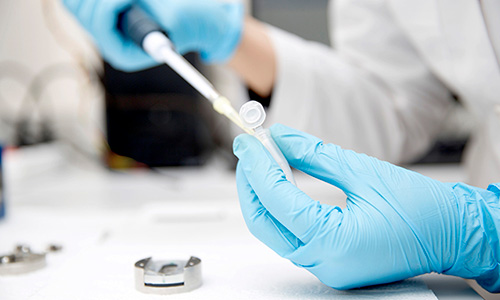
MYTH: The COVID-19 vaccine enters your cells and changes your DNA.
FACT: The COVID-19 vaccines are designed to help your body’s immune system fight the coronavirus. The messenger RNA from two of the first types of COVID-19 vaccines does enter cells, but not the nucleus of the cells where DNA resides. The mRNA does its job to cause the cell to make protein to stimulate the immune system, and then it quickly breaks down — without affecting your DNA.
MYTH: The messenger RNA technology used to make the COVID-19 vaccine is brand new.
FACT: The mRNA technology behind the new coronavirus vaccines has been in development for almost two decades. Vaccine makers created the technology to help them respond quickly to a new pandemic illness, such as COVID-19.
MYTH: The COVID-19 vaccine was developed with or contains controversial substances.
FACT: The first two COVID-19 vaccines to be authorized by the FDA contain mRNA and other, normal vaccine ingredients, such as fats (which protect the mRNA), salts, as well as a small amount of sugar. These COVID-19 vaccines were not developed using fetal tissue, and they do not contain any material, such as implants, microchips or tracking devices.
MYTH: Now that we have a vaccine for COVID-19, we can make vaccines for the common cold, HIV and other diseases.
FACT: The thousands of viruses that cause various diseases are very different. Many change (mutate) year by year, making it difficult to develop one vaccine that works for a long period of time.
Developing vaccines for some disease-causing viruses is tough. For example, the virus that causes HIV can hide and make itself undetectable by the human immune system, which makes creating a vaccine for it extremely difficult.
The common cold can be caused by any one of hundreds of different viruses, so a vaccine for just one of them would not be very effective.
With the COVID-19 vaccine now available for people ages 12 years and older – and availability expected in coming months for people even younger – parents may still have concerns about its safety in children.
In this Q & A, Dr. Jasjit Singh, a pediatric infectious disease specialist and medical director of infection prevention at CHOC, helps settle the misconception that the COVID-19 vaccine affects fertility.
Does the vaccine affect fertility?
No. There is no evidence that the COVID-19 vaccines can impair fertility. There is no biologic plausibility for this.
Why does this theory persist then?
First, let’s have a refresher lesson on how mRNA vaccines – the type of vaccine produced by both Pfizer and Moderna – work. When the vaccine is injected into a body, mRNA – a strip of genetic material – enters the body’s cell and prompts the cell to build copies of spike proteins. These spike proteins are the bumps that protrude from the surface of coronavirus particles. The body’s immune system then learns to spot these spike proteins and produces antibodies and other immune responses that block the virus from entering healthy cells in the future.
There have been claims that a protein called Syncytin-1, which is present in the early development of the placenta, have a similar chemical sequence as the COVID-19 spike protein. The claim is then that a body that has received the vaccine might later confuse the Syncytin-1 protein for a COVID spike protein and block it, ostensibly causing an inability for a body to get pregnant.
But there is no reason to suspect this will happen, and here’s why:
While the two protein sequences do share very small amounts of similarity, they are very, very short sequences. The likelihood of these protein sequences being confused for each other is non-existent.
Do we have proof that people who got the COVID-19 vaccine were able to have children?
Yes. We know that natural COVID-19 infection hasn’t caused infertility. If someone were to have had COVID-19, they’d naturally have antibodies to these spike proteins, and yet women who have had COVID-19 are still getting pregnant. We also know that from earlier trials, an equal number of women who were given the vaccine and who received the placebo shot became pregnant.
Would you give this vaccine to a young woman in your family?
Absolutely yes.
Bigger picture, why do we need to vaccinate teens and kids if their risk of serious COVID-19 complications is low?
Vaccinating children against COVID-19 is very important. We know the disease is not completely benign in children. In addition to requiring some children to be hospitalized for treatment, COVID-19 can lead to an inflammation in children called Multisystem Inflammatory Syndrome in Children (MIS-C). We also know that children with COVID-19 at are risk for long-term complications, the extent to which are still fully unknown. Additionally, there are children who are exhibiting COVID “long haul” symptoms.
Even if a child had no risk of long-term illness or COVID-19 complication, they might still spread the disease to others, who may have more pronounced risks. Further, we need to eliminate pockets of vulnerability where the virus can continue to live and replicate and mutate into new variants. Those new variants may not be as effectively blocked by the vaccine.
In addition, children younger than 18 account for about 22 percent of the population. In order for us to reach a population wherein 70 to 80 percent of people are immune to COVID-19 – a term called “herd immunity” – children must be included in that ratio.
Higher levels of immunity will allow us to continue to open up the economy, resume a normal life and feel very confident in enrolling children in in-person learning, sports and activities. We need kids to return to school for their educational, physical, social and emotional health.
June 17, 2021
Sperm Parameters Before and After COVID-19 mRNA Vaccination
Daniel C. Gonzalez, BS1; Daniel E. Nassau, MD1; Kajal Khodamoradi, PhD1; et alEmad Ibrahim, MD1; Ruben Blachman-Braun, MD1; Jesse Ory, MD1; Ranjith Ramasamy, MD1
Author Affiliations Article Information
JAMA. 2021;326(3):273-274. doi:10.1001/jama.2021.9976
Two mRNA vaccines, BNT162b2 (Pfizer-BioNTech) and mRNA-1273 (Moderna), received Emergency Use Authorization from the US Food and Drug Administration. Despite high efficacy and few adverse events found in clinical trials, only 56% of individuals in the US reported wanting to receive the vaccine.1 One of the reasons for vaccine hesitancy is the potential negative effect on fertility.2 Because reproductive toxicity was not evaluated in the clinical trials and SARS-CoV-2 has been associated with decreases in sperm parameters,3 we assessed sperm parameters before and after mRNA vaccine administration.
Methods
This single-center prospective study at the University of Miami recruited healthy volunteers aged 18 to 50 years scheduled for mRNA COVID-19 vaccination through flyers posted throughout the university hospital and internal list-serve emails. The University of Miami institutional review board approved the study and written informed consent was obtained from all participants.
Men were prescreened to ensure they had no underlying fertility issues. Those with COVID-19 symptoms or a positive test result within 90 days were excluded. Participants provided a semen sample after 2 to 7 days of abstinence, prior to receiving the first vaccine dose and approximately 70 days after the second. Semen analyses were performed by trained andrologists per World Health Organization guidelines and included semen volume, sperm concentration, sperm motility, and total motile sperm count (TMSC).4 Individuals with oligospermia (sperm concentration <15 million/mL) were included. After calculating data distribution on normality test, medians and interquartile ranges (IQRs) were reported for all variables. The Wilcoxon rank sum test was used to compare pre- and postvaccination semen parameters. Change in TMSC is presented graphically. Statistical analysis was performed with SPSS version 24 (IBM). A 2-tailed P < .05 was considered statistically significant.
Results
Between December 17, 2020, and January 12, 2021, 45 men volunteered (median age, 28 years [IQR, 25-31]); follow-up samples were obtained at a median of 75 days (IQR, 70-86) after the second dose. The study ended on April 24, 2021. Baseline samples were obtained after a median abstinence period of 2.8 days (IQR, 2-3) and follow-up samples after a median of 3 days (IQR, 3-4). Of the 45 men, 21 (46.7%) received BNT162b2 and 24 (53.3%) received mRNA-1273. Baseline median sperm concentration and TMSC were 26 million/mL (IQR, 19.5-34) and 36 million (IQR, 18-51), respectively. After the second vaccine dose, the median sperm concentration significantly increased to 30 million/mL (IQR, 21.5-40.5; P = .02) and the median TMSC to 44 million (IQR, 27.5-98; P = .001). Semen volume and sperm motility also significantly increased (Table).
Eight of the 45 men were oligospermic before the vaccine (median concentration, 8.5 million/mL [IQR, 5.1-12]). Of these 8, 7 men had increased sperm concentration to normozoospermic range at follow-up (median concentration, 22 million/mL [IQR, 17-25.5]), and 1 man remained oligospermic. No man became azoospermic after the vaccine.
The waterfall plot shows the within-participant change in TMSC from baseline (range, −22 million to 93 million) for each man (Figure).
Discussion
In this study of sperm parameters before and after 2 doses of a COVID-19 mRNA vaccine, there were no significant decreases in any sperm parameter among this small cohort of healthy men. Because the vaccines contain mRNA and not the live virus, it is unlikely that the vaccine would affect sperm parameters. While these results showed statistically significant increases in all sperm parameters, the magnitude of change is within normal individual variation and may be influenced by regression to the mean.5 Additionally, the increase may be due to the increased abstinence time before the second sample. Men with oligospermia did not experience further decline.
The limitations of the study include the small number of men enrolled; limited generalizability beyond young, healthy men; short follow-up; and lack of a control group. In addition, while semen analysis is the foundation of male fertility evaluation, it is an imperfect predictor of fertility potential. Despite this, the study’s time frame encompasses the full life cycle of sperm.
